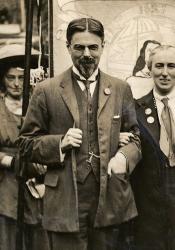Clemence Housman imprisoned for tax resistance
On Friday, September 29th, 1911, Clemence Housman was arrested for purposefully resisting the payment of taxes. This action was born out of her active participation and creative leadership within suffrage movements. Both Clemence and Laurence, who lived in Kensington, were geographically central to the suffrage movements, and loaned their creative skills to the Women’s Freedom League, through their efforts at their Suffrage Atelier. Clemence, with her considerable sewing skills, was the “chief banner-maker of the suffrage movement,” and collaborated with Laurence on the famous banner bearing the slogan “From Prison to Citizenship.”
Clemence’s own tax resistance was part of a larger movement of the Women’s Tax Resistance League (WTRL), which used strategies of civil disobedience to campaign for women’s suffrage. Clemence, who lived with her brother, did not legally have any property on which to pay taxes, so she rented out a house in the rural community of Swanage, where she eluded the census of 2 April 1911. An entry in her diary at this time was “No Vote No Census Clemence Housman.” Along with other WTRL members, Clemence refused to pay taxes on her rental property in 1911, and was admonished in a government letter in July, to which she replied that she was on holiday and unable to pay taxes. Finally, on September 29th, the tax authorities caught up with her, and she was arrested from her Kensington house. The suffrage community gathered at her house to show support, and Laurence himself escorted her to Holloway Prison. Immediately after her incarceration, Clemence petitioned the home office explaining her reason for alluding taxes, that she felt that she had “personally fulfilled a duty, moral, social and constitutional, by refusing to pay petty taxes into irresponsible hands.” At this time, Laurence commented to the press: "when they give her her freedom, she will do it again until representation has been granted." Clemence was released from Holloway quietly on 6 October, an event that attracted considerable press because of the position of her and her family within the artistic and suffrage communities. A special cable to the New York Times called Clemence a "Suffragette Martyr" (Liddington, Vanishing for the Vote; "Suffragette Martyr," The New York Times).

